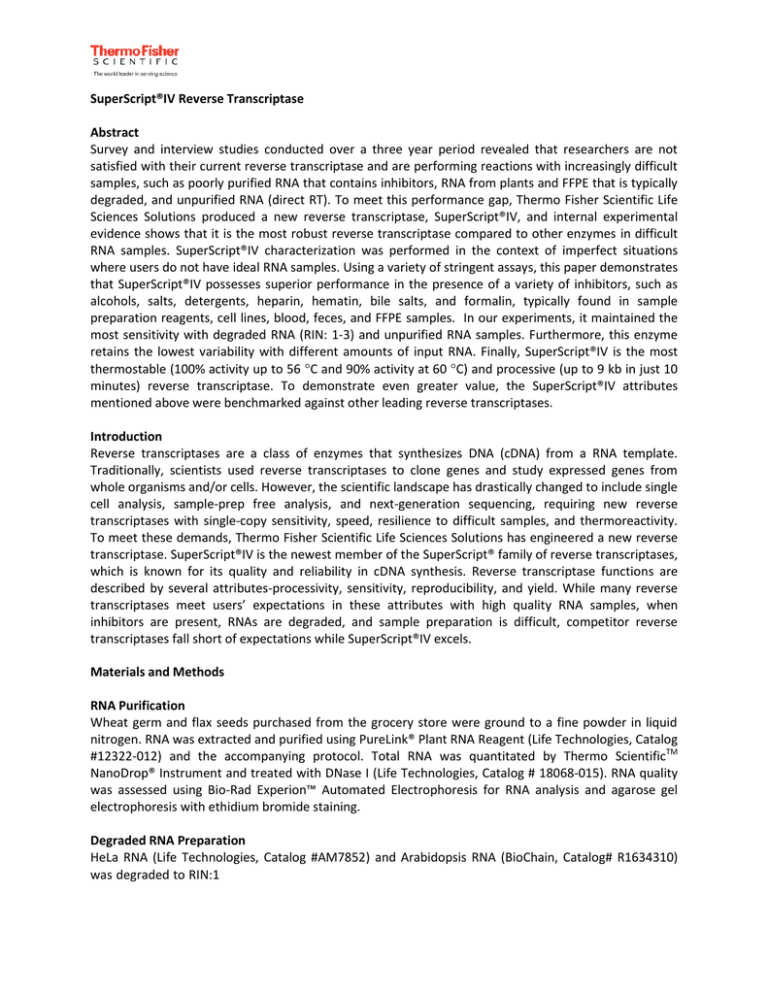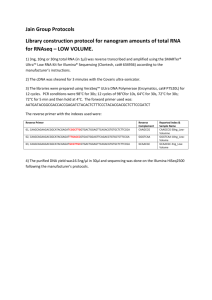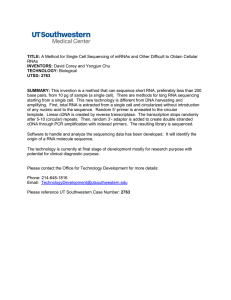
SuperScript®IV Reverse Transcriptase
Abstract
Survey and interview studies conducted over a three year period revealed that researchers are not
satisfied with their current reverse transcriptase and are performing reactions with increasingly difficult
samples, such as poorly purified RNA that contains inhibitors, RNA from plants and FFPE that is typically
degraded, and unpurified RNA (direct RT). To meet this performance gap, Thermo Fisher Scientific Life
Sciences Solutions produced a new reverse transcriptase, SuperScript®IV, and internal experimental
evidence shows that it is the most robust reverse transcriptase compared to other enzymes in difficult
RNA samples. SuperScript®IV characterization was performed in the context of imperfect situations
where users do not have ideal RNA samples. Using a variety of stringent assays, this paper demonstrates
that SuperScript®IV possesses superior performance in the presence of a variety of inhibitors, such as
alcohols, salts, detergents, heparin, hematin, bile salts, and formalin, typically found in sample
preparation reagents, cell lines, blood, feces, and FFPE samples. In our experiments, it maintained the
most sensitivity with degraded RNA (RIN: 1-3) and unpurified RNA samples. Furthermore, this enzyme
retains the lowest variability with different amounts of input RNA. Finally, SuperScript®IV is the most
thermostable (100% activity up to 56 C and 90% activity at 60 C) and processive (up to 9 kb in just 10
minutes) reverse transcriptase. To demonstrate even greater value, the SuperScript®IV attributes
mentioned above were benchmarked against other leading reverse transcriptases.
Introduction
Reverse transcriptases are a class of enzymes that synthesizes DNA (cDNA) from a RNA template.
Traditionally, scientists used reverse transcriptases to clone genes and study expressed genes from
whole organisms and/or cells. However, the scientific landscape has drastically changed to include single
cell analysis, sample-prep free analysis, and next-generation sequencing, requiring new reverse
transcriptases with single-copy sensitivity, speed, resilience to difficult samples, and thermoreactivity.
To meet these demands, Thermo Fisher Scientific Life Sciences Solutions has engineered a new reverse
transcriptase. SuperScript®IV is the newest member of the SuperScript® family of reverse transcriptases,
which is known for its quality and reliability in cDNA synthesis. Reverse transcriptase functions are
described by several attributes-processivity, sensitivity, reproducibility, and yield. While many reverse
transcriptases meet users’ expectations in these attributes with high quality RNA samples, when
inhibitors are present, RNAs are degraded, and sample preparation is difficult, competitor reverse
transcriptases fall short of expectations while SuperScript®IV excels.
Materials and Methods
RNA Purification
Wheat germ and flax seeds purchased from the grocery store were ground to a fine powder in liquid
nitrogen. RNA was extracted and purified using PureLink® Plant RNA Reagent (Life Technologies, Catalog
#12322-012) and the accompanying protocol. Total RNA was quantitated by Thermo ScientificTM
NanoDrop® Instrument and treated with DNase I (Life Technologies, Catalog # 18068-015). RNA quality
was assessed using Bio-Rad Experion™ Automated Electrophoresis for RNA analysis and agarose gel
electrophoresis with ethidium bromide staining.
Degraded RNA Preparation
HeLa RNA (Life Technologies, Catalog #AM7852) and Arabidopsis RNA (BioChain, Catalog# R1634310)
was degraded to RIN:1
Unpurified RNA or Direct Reverse Transcription Samples
Pelleted HeLa cells, Arabidopsis tissue, wheat germ tissue, and flax seed tissue was ground to a fine
powder in liquid nitrogen. The powder was transferred to a microfuge tube and TE was added, vortexed,
and centrifuged to pellet debris. Resulting clarified supernatant was transferred into a fresh microfuge
tube. Prior to reverse transcription, EDTA and DTT was added to the supernatant to a final concentration
of 1 mM and 5 mM respectively, and heated to 95 C for 10 minutes.
Reverse Transcription
Commercial RNA utilized included Cervical Adenocarcinoma (HeLa-S3) Total RNA (Life Technologies,
Catalog# AM7852), Arabidopsis Total RNA (BioChain, Catalog# R1634310), Rat Brain Total RNA
(Clontech, Catalog# 636653), 0.5-10 kb RNA Ladder (Life Technologies, Catalog# 15623-200), and RNA
Millennium™ Markers (Life Technologies, Catalog# AM7150).
qPCR
Reverse transcription reaction (cDNA) composed up to 10% of total qPCR reaction volume. TaqMan®
assays for the gene targets are indicated in the figures. EXPRESS qPCR SuperMix (Life Technologies,
Catalog #11785-01K) and the ViiA™ 7 Real-Time PCR System (Life Technologies, Catalog #4453536) were
utilized. Ct values were normalized to SuperScript®IV using the equation: Normalized Y
values=[2^(CtSS®IV- CtSS®IV)]/[2^(Ctcompetitor- CtSS®IV)]
Endpoint PCR
Reverse transcription reaction (cDNA) composed up to 10% of total PCR reaction volume and utilized
Platinum® Taq DNA Polymerase, High Fidelity and accompanying protocol. 10 µL of PCR reaction was
resolved using agarose gel electrophoresis and visualized by ethidium bromide staining.
Activity Assay for Thermostability
Reverse transcriptases were preincubated at the indicated temperatures for an indicated amount of
time in 1x reaction buffer and 100 ng/µL calf thymus DNA (Life Technologies, Cat# 15633-019). Following
preincubation, enzymes were added to a 1x polymerization mix containing 1x reaction buffer, 2 mM
oligo(dT)16, 0.02 µg poly(rA)(GE Healthcare, Catalog# 45-001-356), 2 mM dTTP, and 1x EvaGreen® dye
(Biotium, Catalog# 31000-1mL). Extension was performed for 10 minutes at room temperature.
Fluorescence was read using the Molecular Devices SpectraMAX® Gemini EM plate reader with an
excitation/emission of 490/520 nm. % activity remaining after heat treatment was determined by
normalizing to the fluorescence reading without heat treatment that is set to 100%.
First-Strand cDNA Synthesis for Thermostability
Reverse transcription was performed as described above using oligo(dT)20 and 500 ng RNA Millennium™
Markers (Life Technologies, Cat# AM7150) except reaction temperature ranged from 50-65 C.
SuperScript®III reactions was performed according to accompanying protocol except reaction
temperature ranged from 50-65 C and reaction time was 50 minutes. First-strand cDNA were resolved
by alkaline gel electrophoresis and cDNA was stained using SYBR® Gold (Cat# S-11494). NaOH hydrolyzes
all RNA resulting in only visualization of cDNA. Each cDNA band was measured by TotalLab and volumes
were summed up for each reaction temperature. Percent activity was calculated by taking the ratio of
total volume at each reaction temperature to the total volume at 50 C.
Results
SuperScript®IV and Competitor Reverse Transcriptase RT-qPCR Performance in Inhibitors
Trace amounts of reagents used during RNA isolation will cause problems with reverse transcription. For
example, some reagents used to lyse cells, such as SoluLyse™ and BugBuster® reagents, contain
detergents. TRIzol® reagent, used to extract RNA from cells and tissue, contains phenol. Salts, such as
guanidinium chloride, guanidinium isothiocyante, ammonium acetate, and lithium chloride are in
multiple steps during RNA isolation and precipitation. FFPE samples may still contain formalin and
paraffin. Inhibitors may also be inherent in the biological sample source, such as hematin, a drug found
in blood, bile salt, found in blood and feces, and humic acid, found in soil and thus, on plants. To test
how chemical compounds effect reverse transcription efficiency, possible inhibitors were added to total
HeLa RNA prior to the oligo(dT)20 annealing step. Concentrations indicated in the figures are the final
concentrations of inhibitors in complete reverse transcription reactions. Reverse transcription with
SuperScript®IV (red bars), SuperScript®III, and six other competitor reverse transcriptases (P, T, BR, Q,
BL, and N) followed by qPCR revealed the SuperScript®IV had the most consistent results with all the
inhibitors tested. SuperScript®IV functions exceedingly better than all tested enzymes in the presence of
ethanol, SoluLyse™, salts, hematin, and humic acid. Competitor “N” RT gave ~5-fold more product than
SuperScript®IV. Competitor “BL” RT is about equivalent to SuperScript®IV in BugBuster®. Competitor
“BR” and “BL” RTs functioned better than SuperScript®IV in formalin. Since the majority of reverse
transcriptases functioned more comparably in paraffin, this wax component in FFPE samples cause little
or no inhibition to reverse transcription. In summary, SuperScript®IV demonstrated the most consistent
performance in a variety of inhibitors.
Figure 1
SuperScript®IV and Competitor Reverse Transcriptase First-strand cDNA Synthesis Performance in
Inhibitors
In addition to studying the effect of inhibitors on RT-qPCR, direct analysis of reverse transcriptase
activity in the presence of inhibitors was also performed. RT-qPCR may hide the actual performance of
RTs because targets are usually less than 200 bp and thus, much easier to reverse transcribe. Therefore,
analysis of first-strand cDNA synthesis using RNA targets of different sizes gives a more accurate
representation of reverse transcriptase performance. First-strand cDNAs resulting from reverse
transcription of a 0.5-10 kb RNA ladder were resolved by alkaline gel electrophoresis that degrades RNA.
Single-stranded cDNA was visualized by staining with SYBR® Gold. Contrary to RT-qPCR of small targets,
(Figure 1), the reverse transcription of longer targets revealed that the enzymes are more susceptible to
inhibitors in general. In isopropanol, Competitor “N” RT does not make any cDNAs of at least 0.5 kb
while SuperScript®IV can still synthesize up to 1 kb. In BugBuster®, SSIV can synthesize up to 8 kb, while
Competitor “BL” RT makes very little cDNA and stops after ~1.5 kb. The same effect is observed for
formalin where Competitor “BL” and “BR” RTs have trouble with cDNA yield and length while
SuperScript®IV retains most of its activity. Other inhibitors tested by direct cDNA analysis encompass
inhibitors inherent in biological samples, such as heparin found in animal blood, tissue, and cells and bile
salts found in blood and feces. Using analysis of just first-strand cDNA, SuperScript®IV exceeds all
competitor reverse transcriptases. The exception is bile salts where SuperScript®III also retains most of
its activity. Positive control experiments where no inhibitors are added to reverse transcription revealed
that competitor “BL”, “P”, “Q”, and “BR” RTs cannot synthesis target greater than 2 kb even when
conditions are ideal.
Figure 2
SuperScript®IV and Competitor Reverse Transcriptase Performance with Degraded RNA Samples
Sensitivity or the ability of reverse transcriptases to generate cDNA from very little input RNA is an
important attribute to this class of enzyme. Furthermore, researchers are working with increasingly
difficult sample sources where RNA becomes degraded during the RNA purification process resulting in
even lower yields of full length transcripts. Reverse transcriptase sensitivity was therefore evaluated in
the context of degraded RNA from HeLa cells, Arabidopsis, wheat germ, and flax seeds. RIN values
ranged between 1-3 contrary to high quality intact RNA with a RIN greater than 8. Nine targets were
evaluated by qPCR and in every case, SuperScript®IV (red bars) was more sensitive than other enzymes
tested.
Figure 3
SuperScript®IV and Competitor Reverse Transcriptase Performance with Unpurified RNA Samples
The data presented earlier demonstrates SuperScript®IV is the most robust and sensitive reverse
transcriptase in the context of inhibitors and degraded RNA. However, researchers face a combination
of problems with their samples. To challenge reverse transcriptases with a “real world” scenario, direct
reverse transcription was performed with unpurified RNA samples. Ground 293 cells, Arabipdopsis
tissue, and wheat germ tissue was mixed with TE to dissolve RNA which was then added directly to
reverse transcription reactions. Thus, the input samples have very low copies of transcripts and a variety
of inhibitors. For seven qPCR targets in 293 cells, Arabidopsis tissue, and wheat germ tissue,
SuperScript®IV (red bars) is the most sensitive. Most reverse transcriptases performed well for GAPDH in
wheat germ. Nonetheless, SuperScript®IV is the most consistently robust enzyme for direct reverse
transcription.
Figure 4
SuperScript®IV and Competitor Reverse Transcriptase Sensitivity and Variability with Degraded Plant
RNAP </MCID 2>> BDC BTm
BT1 0 0 1 225.4t
Figure 5
SuperScript®IV and Competitor Reverse Transcriptase Processivity Study
Processivity is the ability of a polymerase to perform consecutive nucleotide additions without releasing
the RNA template. The more processive an enzyme, the longer the cDNA that can be synthesized and
the faster the enzyme is in making full length cDNA. The speed and length of reverse transcriptases was
assessed using a 0.5-9 kb RNA ladder. Reverse transcriptase reaction time was held constant for 10
minutes. Only SuperScript®IV synthesized up to the 9 kb cDNA. SuperScript®III can synthesize up to 5 kb
while the rest of the competitor enzymes failed by 3 kb indicating that SuperScript®IV is the most
processive reverse transcriptase.
Figure 6
SuperScript®IV and Competitor Reverse Transcriptase Thermostability Study
Thermostability of the reverse transcriptases was evaluated by preincubating at 50 C from 0-90
minutes. Following preincubation, polymerization activity was measured using a fluorescent activity
assay. Only SuperScript®III and IV remained active at 50 C for a sustained period of time. SuperScript®III
and SuperScript®IV thermostability was more stringently evaluated from 50 C-65 C by measuring firststrand cDNA synthesis of a 0.5-9 kb RNA ladder. The yield and length of this RNA ladder dropped
drastically with temperatures slightly above 50 C for SuperScript®III. However, SuperScript®IV sustains
100% activity up to 56.4 C and 70% activity up to 65 C. SuperScript®IV’s ability to function at higher
temperatures enables the reverse transcription of RNA targets with strong secondary structure.
Figure 7
SuperScript®IV and Competitor Reverse Transcriptase cDNA Length Study
Although most processed RNAs are around 3 kb, there are genes that exceed this size. To evaluate the
performance of reverse transcriptases with longer transcripts, reverse transcription followed by
endpoint PCR was performed for 12.3 kb in vitro transcript. The reverse transcription protocol was
modified to include a gene-specific RT primer. Reverse transcription reaction incubation was 30 min at
recommended reaction temperature, 15 min at 5 C above recommended reaction temperature, and 15
min 10 C above recommended reaction temperature for all enzymes tested to accommodate for
secondary structure and large transcript size. Subsequent PCR resulted in a 12.3 kb product in only the
SuperScript®IV reaction while all other reverse transcriptases produced smears and smaller products.
Figure 8
Conclusion
Scientific advancement requires researchers to continually undertake new challenges and obtain results
more rapidly. Thermo Fisher Scientific strives to meet the needs of the scientific community by
continuously evolving its reagents and tools for current and future research. The SuperScript®IV reverse
transcriptase is such an example. SuperScript®IV enables scientists to quickly progress their research by
providing sensitive and reliable RNA analysis from difficult sample sources that contain low copies of
target RNA, degraded RNA, and inhibitors. SuperScript®IV raises the bar by enabling scientists to analyze
RNA without purification.
© 2015 Thermo Fisher Scientific Inc. All rights reserved. All trademarks are the property of Thermo
Fisher Scientific and its subsidiaries unless otherwise specified. TaqMan is a registered trademark of
Roche Molecular Systems, Inc., used under permission and license. Experion is a trademark of Bio-Rad
Laboratories, Inc. EvaGreen is a trademark of Biotium, Inc. SpectraMAX is a trademark of Molecular
Devices, LLC. TRIzol is a trademark of Molecular Research Center, Inc. BugBuster is a trademark of
Merck, KGAA. SoluLyse is a trademark of Genlantis, Inc.




